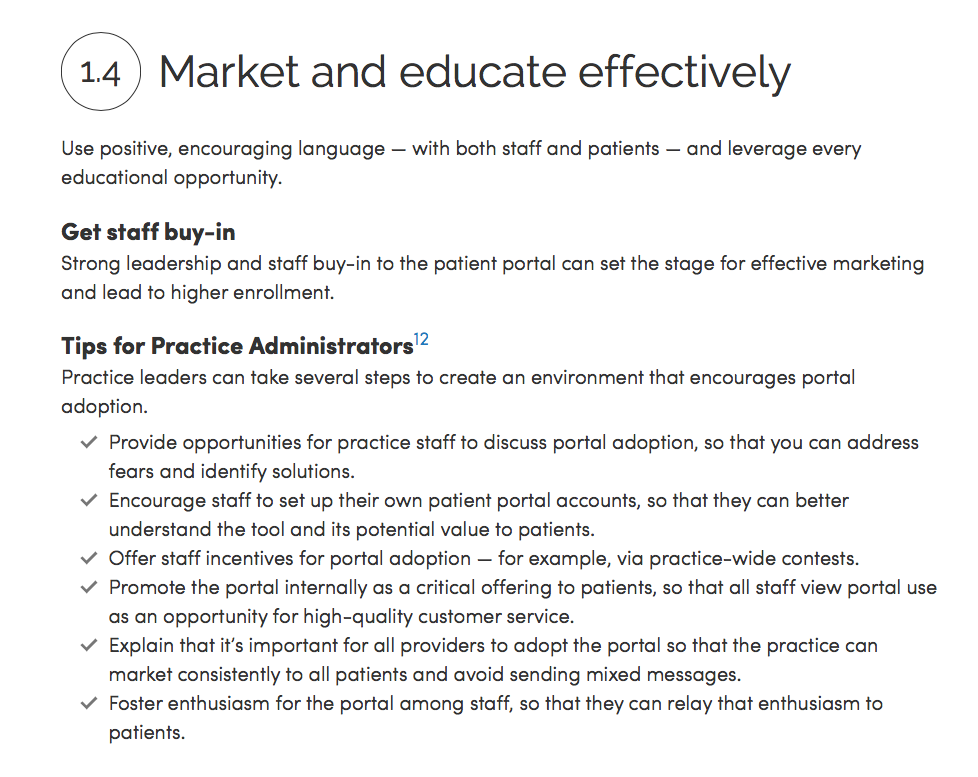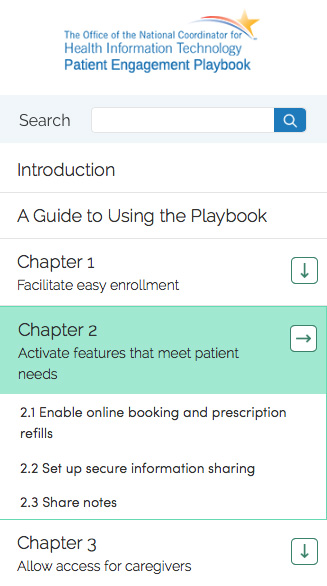By Linda Harris, ODPHP and Lana Moriarty, Director of Consumer eHealth, ONC
When we developed Health Literacy Online: A Guide for Simplifying the User Experience, we set out to help people create online health information and digital tools that are accessible and easy to understand for users with limited literacy skills.
But the truth is that these principles and strategies don’t just benefit consumers with limited literacy skills, they benefit all online users — even health care professionals.
The Office of the National Coordinator for Health Information Technology (ONC) has proven that fact with the ONC Patient Engagement Playbook (PE Playbook), an engaging, user-friendly resource for health care professionals that was developed using Health Literacy Online recommendations and principles.
The PE Playbook is a tool that helps health care providers, practice staff, and hospital administrators use health information technology (health IT) — specifically electronic health record (EHR) patient portals — to provide better care. It’s designed to help health care professionals:
- Facilitate easy enrollment to achieve greater portal adoption
- Meet patient needs online — while also streamlining practice workflow
- Involve caregivers in an appropriate way
- Integrate patient-generated health data to improve clinical decision-making and care
So what takeaways from Health Literacy Online can we see in the PE Playbook?
Clear, actionable content

Content is the most important part of any health website or digital tool. In general, if people have come to your site, they’re looking for answers to specific questions — and they want to be able to find those answers fast.
The PE Playbook is filled with specific, actionable suggestions for health care professionals looking to engage patients in their health and care through the use of patient portals. Action steps are clear and in the active voice, and the Playbook uses headings and subheadings to relay key information.
Simple navigation

Simple navigation makes it easy for users to find the content that’s relevant to them, move from one topic to another, or go back if they suddenly find themselves somewhere they don’t want to be.
The PE Playbook’s navigation offers users different ways to find the information they want: they can use the chapter-specific buttons or look for more specific information using the search bar at the top of the navigation.
Opportunities for engagement
By involving users in your content, you will motivate them to take action.
The entire PE Playbook is designed with engagement in mind. Users can quickly and easily:
- Fill out streamlined forms to sign up for updates and give feedback
- Print out the full Playbook or specific chapters for training purposes
- Share the Playbook (or certain sections of the Playbook) on social media
- Click through interactive graphics that illustrate how they can integrate Playbook tips into their work
The PE Playbook is now an integral part of the new Health IT Playbook, which ONC launched on Monday, September 26, the first day of National Health IT Week. The Health IT Playbook is a dynamic, web-based resource designed to help providers use health IT through a mix of practical, technical, and workflow tips and a variety of tools and resources.
The application of Health Literacy Online to the development of the ONC Patient Engagement Playbook and the new Health IT Playbook is an important reminder that online health information should always be clear, actionable, engaging, and easy to use. This is true when the audience is consumers — no matter the level of literacy skills — and it’s true when the audience is health care professionals.
When clear content happens, everyone wins.